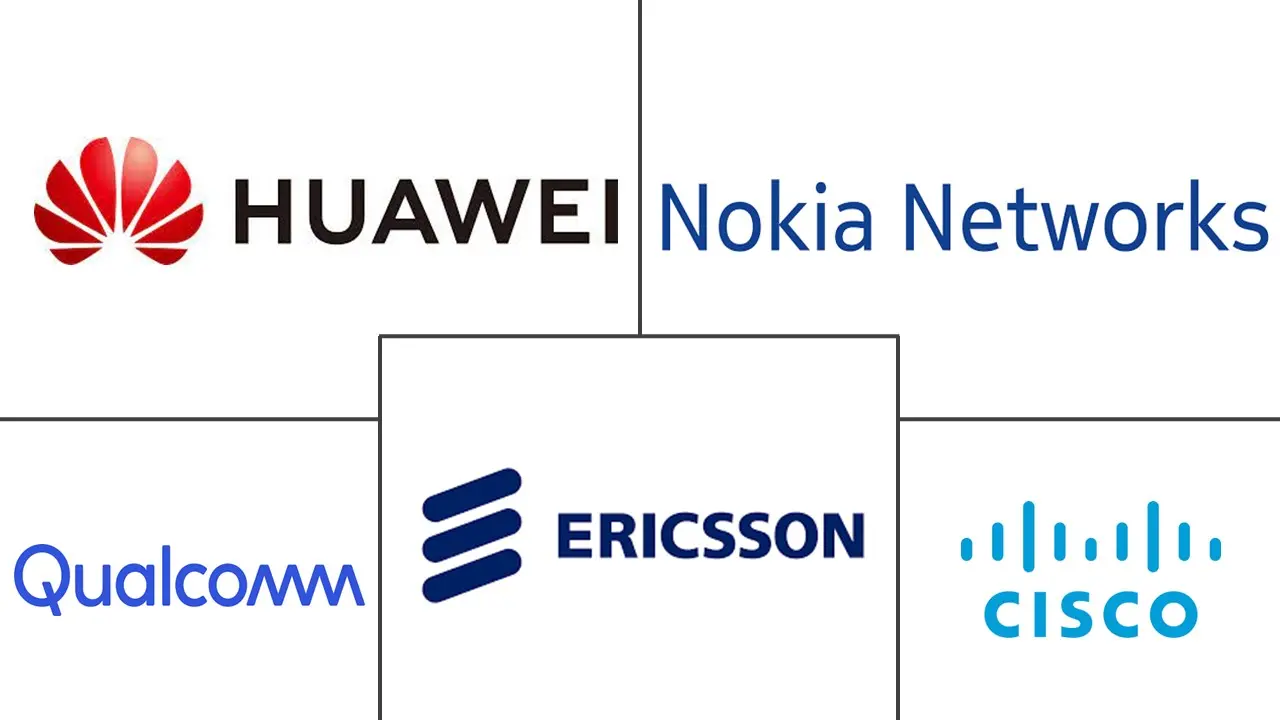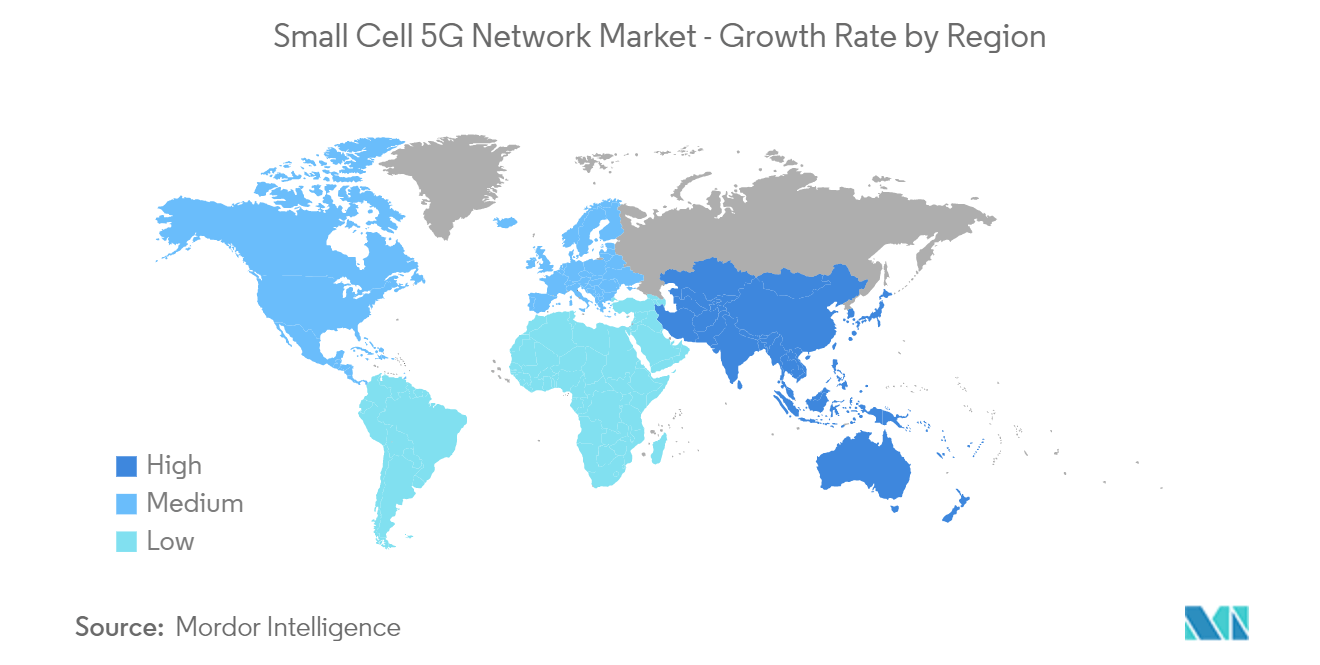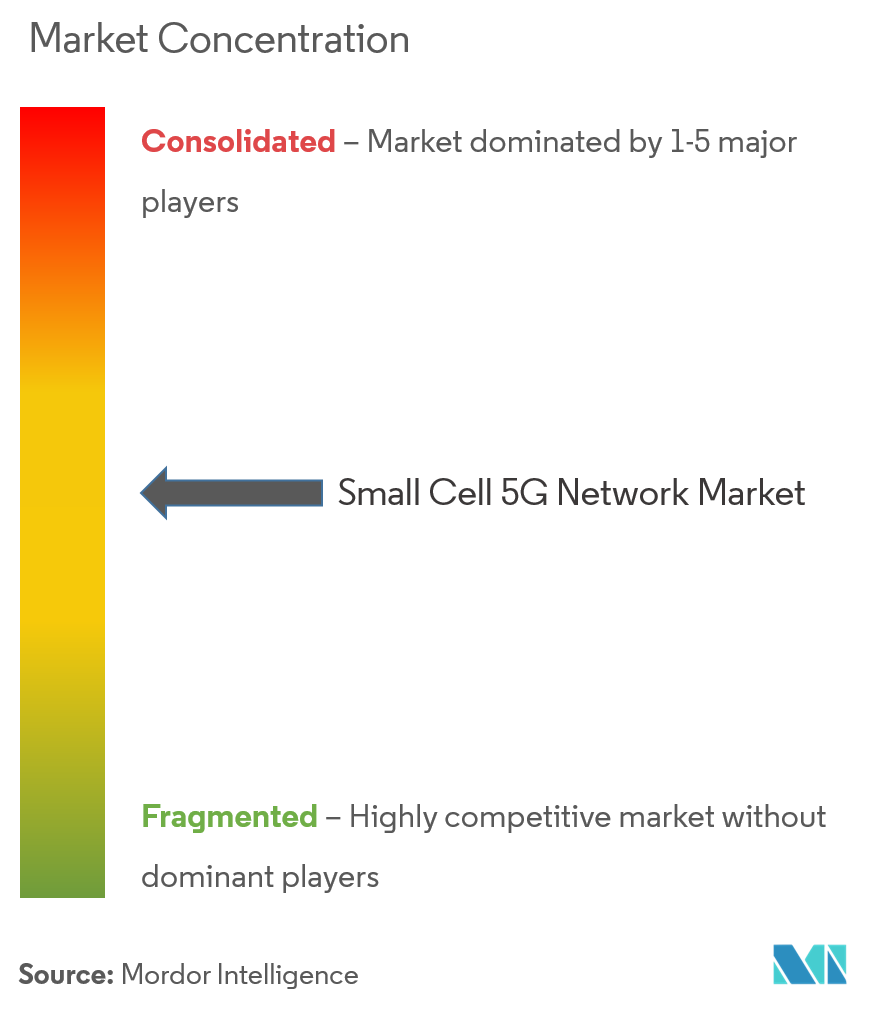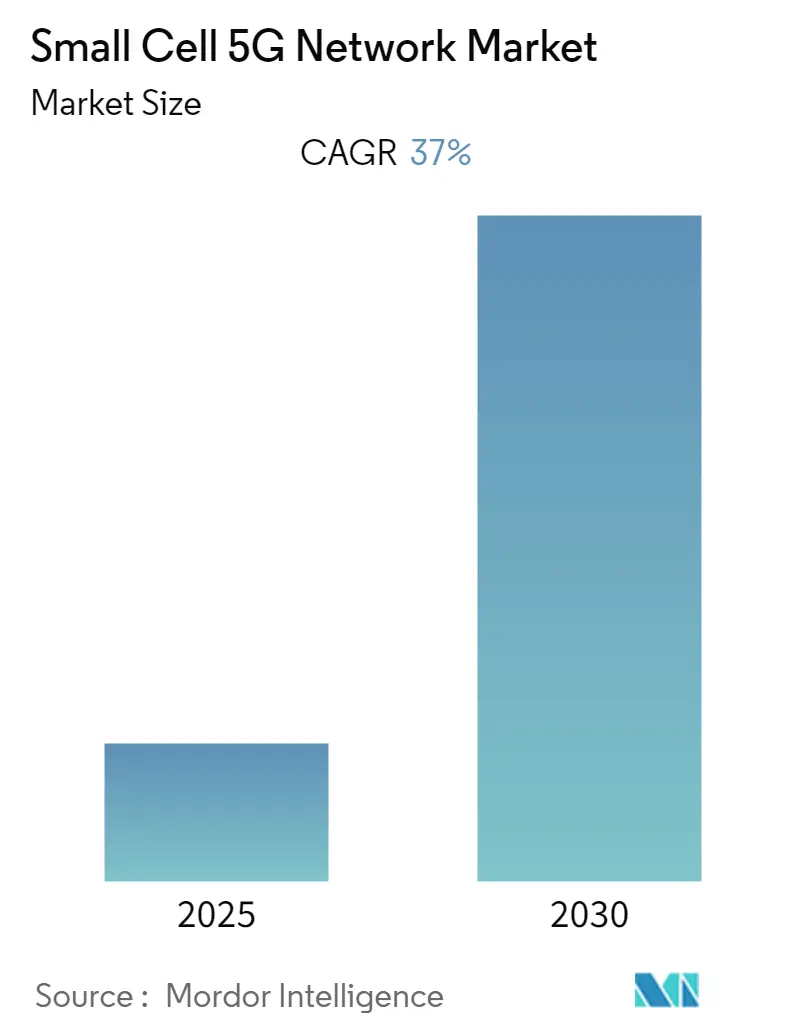
Small Cell 5G Network Market Analysis
The Small Cell 5G Network Market is expected to register a CAGR of 37% during the forecast period.
- Small cells are expected to be the foundation of future global 5G networks. The deployment of 5G small cells at a large scale and required speed worldwide is made possible by industry coordination, making 5G a reality. Although 5G promises to be cheaper and faster, it requires expanding the wireless network using small cells.
- Small cells are essential in the current environment, particularly for applications that demand more bandwidth and the growing number of connected devices. For example, Cisco Systems Inc predicts that 500 billion devices will be online by 2030. Additionally, 5G telecom providers are focused on installing small cells in low-frequency bands to provide customers better coverage.
- The increasing mobile data traffic is driving the market growth. According to the Cisco Visual Networking Index (VNI), global mobile data traffic increased at a CAGR of 46% from 2017 to last year, reaching 77.5 exabytes per month. In the previous year, a 5G connection produced around 2.6 times as much traffic as the typical 4G connection, according to Cisco's study.
- Small cell deployment is a top priority for various operators, with 60% of operators believing them to be a crucial component of their 4G services. Leading carriers such as Vodafone, AT&T, and Softbank have already implemented small-cell technologies in addition to their macro networks. For example, Verizon has installed small cells in several US cities, including New York, Chicago, Atlanta, and San Francisco.
- In addition, 5G can be deployed on existing cellular radio frequencies but may enable operators to use higher radio frequencies (over 20 GHz) to make it operable, especially for mobile services. However, deployment at these frequencies is only possible in constrained areas, and signal penetration is restricted as it does not go through walls. This increases the adoption of small cells for in-building applications, with excellent connectivity for smartphones and IoT devices.
- The COVID-19 outbreak had a significant impact on the mobile sector. In the short term, the 5G rollout in several markets will be further delayed, and its services will be the hardest hit. Consumers may be unable to spend on small cell 5G devices as it is still considered a niche market. According to Groupe Speciale Mobile Association (GSMA) Intelligence's consumer survey, most respondents had limited interest in upgrading to 5G services. For instance, according to the report, nearly 80% of consumers in the United Kingdom did not plan to upgrade.
Small Cell 5G Network Market Trends
Telecom Operators Segment is Expected to Grow Significantly
- Small cells are equipped to handle large data rates for mobile broadband and IoT users and dense populations of low-speed and low-power devices, making them ideal for the 5G rollout. This characteristic offers millisecond latencies, a million devices per square mile, and extremely high speeds. As a result, telecom operators worldwide are mainly using small cell technology to bring out 5G technology. According to IoT company Telit, major US telecom companies plan to rely heavily on small cell technology for 5G coverage nationwide.
- To boost the initiative of providing 5G coverage to consumers, Taiwan's largest telecom operator, Chunghwa Telecom (CHT), teamed up with Nokia for products from its small cells portfolio. In Taiwan, CHT was the first operator to roll out 5G non-standalone (NSA) small cells, providing instant 5G coverage in several places, including commercial and tourism locations.
- Nokia will provide CHT with its adaptable AirScale indoor Radio (ASiR) solution and its AirScale micro RRH for outdoor and urban hotspots to improve interior coverage and capacity. In addition to CHT's current base of more than 2,500 sets of 4G small cells, these two solutions will help operators meet the needs of a 5G network's indoor coverage and densification.
- Furthermore, the Small Cell Forum (SCF), a telecoms organization that makes mobile infrastructure solutions available to everyone, issued a PHY API for 5G, which has sparked a competitive ecosystem for suppliers of 5G small cell hardware, software, and equipment. Telecom providers benefit from the competitive ecosystem of the SCF by driving up the demand for the 5G network as the demand for data usage and high-speed data rises.
- For 5G technologies and networks, telecom operators are searching for a fundamentally new pricing model that might rely on interoperability and an open, competitive environment. As networks get decentralized, the front haul between a distributed unit (DU) for radio functions and a centralized unit (CU) for protocol stacks and baseband functions is a crucial interface.
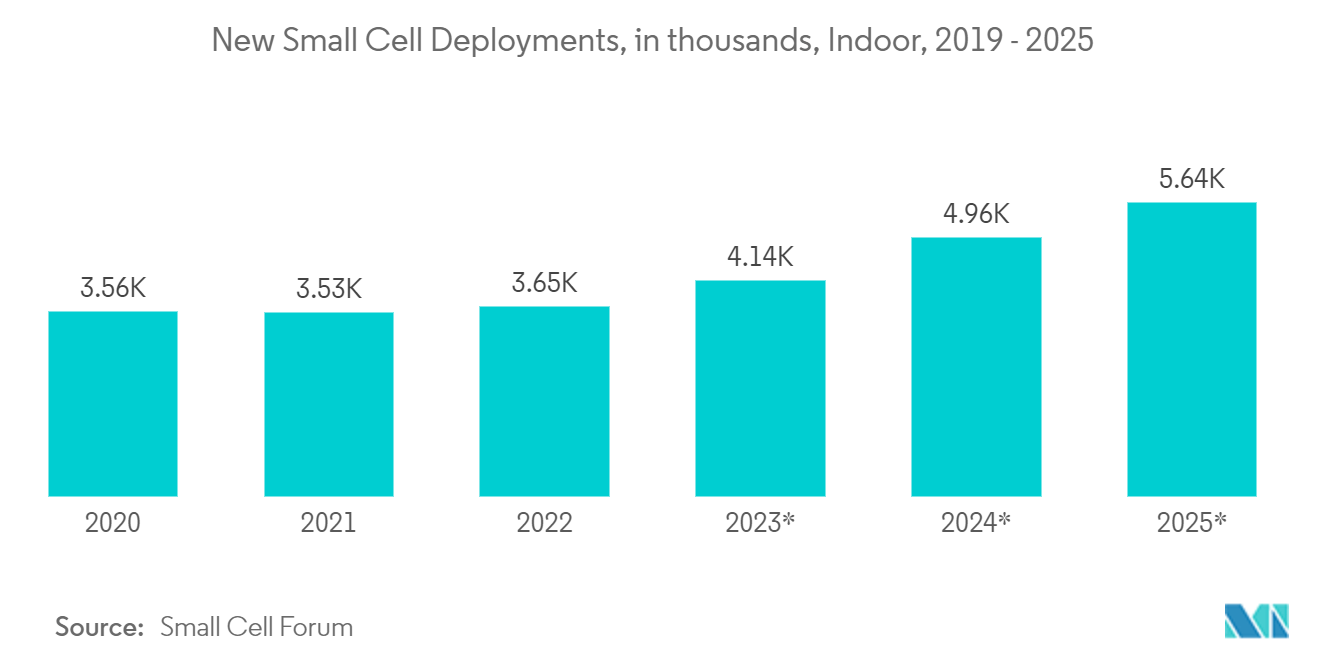
North America is Expected to Hold a Significant Market Share
- North America is considered one of the leading markets due to its widespread use of advanced technology like 5G. In the United States, telecom operators are leveraging small cells to densify their 5G network, particularly in metropolitan areas, while reducing costs. Major operators like Sprint, AT&T, Verizon, and T-Mobile have shown a positive approach toward commercializing 5G networks, with billion-dollar agreements made with network equipment manufacturers such as Samsung, Ericsson, Nokia, Huawei, and ZTE to develop their 5G network infrastructure.
- Wireless network operators in the United States are largely embracing small cells. CTIA, the trade association, has forecasted that by 2026, there will be more than 800,000 small cells in the United States, up from about 86,000 in 2018. After the acquisition of Sprint Corporation by T-Mobile US, they have about 70,000 small cells together. The company plans to pour significant amounts of spectrum onto the biggest and densest wireless network in the United States. However, Verizon's small cell strategy differs from T-Mobile's. It expects mmWave to handle 50% of urban traffic eventually and aims to continue deploying around 14,000 small cells over the next few years to expand the overall coverage.
- According to the Ericsson Mobility Report, by 2024, 5G subscriptions are anticipated to make up 55% of all mobile subscriptions in the North American region. The market is expected to benefit from the increase in 5G subscriptions over the projected period.
- In June 2021, Qualcomm Technologies Inc. launched its second-generation Qualcomm 5G RAN Platform for Small Cells (FSM200xx) in the United States. The platform is designed to expand mobile 5G mmWave coverage and power efficiency, providing data speeds of up to 8 Gbps with bandwidth support of 1 GHz on mmWave, wider 200MHz carrier bandwidth support, and 200 MHz of Sub-6 GHz spectrum aggregation across FDD and TDD, providing data rates of up to 4 Gbps. It also supports technologies like eURLLC to provide low latency and link dependability essential for factory automation and mission-critical control of equipment and machines.
- Ericsson has also collaborated with Rogers Communications Inc., a Canadian communication and media company, to install 5G across its network in Canada. The 5G radio access network (RAN) and 5G core (5GC) for Rogers' 5G network are exclusively supplied by Ericsson, and small cells, conventional and Massive MIMO radios, and MINI-LINK microwave technologies are also part of the technology. The Rogers 5G network is initially using a 2.5 GHz band and will expand to operate on the 600 MHz 5G spectrum as the service expands to other markets.
Small Cell 5G Network Industry Overview
The market for small cell 5G networks is moderately consolidated. Some of the key existing vendors in the market include Nokia Networks, Cisco Systems Inc., Telefonaktiebolaget LM Ericsson, and Qualcomm Technologies Inc., among others. These companies implement product development, strategic partnerships, and mergers & acquisitions to launch new products. However, many new vendors, such as Baicells Technologies Co. Ltd, have entered the market, which may change the competitive landscape throughout the forecast period.
In October 2023, Samsung unlocked access to its innovative “Strand Small Cell,” which is targeted at cable telecommunication providers interested in expanding the reach of their 5G-based cellular services using already owned infrastructure and spectrum holdings. The all-in-one platform was initially unveiled last year in partnership with Comcast as core to the cable giant’s plans to supplement cellular services through a mobile virtual network operator (MVNO) agreement with Verizon. It’s now available to all interested parties.
In October 2023, Vodafone and Nokia announced a strengthening of their partnership with plans to run a commercial 5G Open radio access network (RAN) pilot in Italy for the first time. Bringing together Nokia, one of the world’s largest RAN providers, and Vodafone’s unrivaled pan-European network will provide a platform for more independent software providers and local companies to enter the fray using open APIs. This will encourage competition and innovation, boosting Europe’s competitiveness and giving it greater digital autonomy underpinned by a more resilient supply chain.
Small Cell 5G Network Market Leaders
-
Nokia Networks
-
Qualcomm Technologies Inc.
-
Huawei Technologies Co. Ltd
-
Telefonaktiebolaget LM Ericsson
-
Cisco Systems Inc.
- *Disclaimer: Major Players sorted in no particular order
Small Cell 5G Network Market News
- In March 2023, Telecom gear maker HFCL marked up Metanoia Communications and NXP Semiconductors’ for its 5G New Radio (NR) indoor small cell solution. At the same time, Metanoia will supply its 5G-NR RF transceiver. According to a joint statement, NXP will provide its Layerscape and Layerscape Access family of processors for HFCL’s all-in-one 5G 2T2R indoor small cell.
- In February 2023, Maxlinear, Inc. announced it has collaborated with EdgeQ on an all-in-one small cell connection design, converging 4G, 5G, and computing onto a single software-defined platform. Incorporating EdgeQ’s 5G Base Station-on-a-chip with Maxlinear’s MXL1600 RF transceiver and Maxlin wideband digital pre-distortion (DPD) solution creates a new software-programmable paradigm that lets creators scale rapidly and dynamically across the wide range of small cell applications and use subjects with a high level of system integration, performance, and flexibility.
Small Cell 5G Network Industry Segmentation
Small cells are low-power, short-range wireless transmission systems primarily designed to serve indoor and outdoor applications or a restricted geographic area. Small cells are crucial to delivering low-latency apps and high-speed mobile broadband in 5G deployments. Small cells are further classified into subcategories like a microcell, metro cells, picocells, and femtocells based on their coverage area and user capacity. Telecom operators, households, and businesses are among the small cell's end users.
The small cell 5g network market is segmented by operating environment (indoor, outdoor), end-user vertical (telecom operators, enterprises, residential), and geography (North America, Europe, Asia Pacific, and the Rest of the World).
The market sizes and forecasts are provided in terms of value (USD) for all the above segments.
| By Operating Environment | Indoor |
| Outdoor | |
| By End-User Vertical | Telecom Operators |
| Enterprises | |
| Residential | |
| By Geography | North America |
| Europe | |
| Asia Pacific | |
| Rest of the World |
Small Cell 5G Network Market Research FAQs
What is the current Small Cell 5G Network Market size?
The Small Cell 5G Network Market is projected to register a CAGR of 37% during the forecast period (2025-2030)
Who are the key players in Small Cell 5G Network Market?
Nokia Networks, Qualcomm Technologies Inc., Huawei Technologies Co. Ltd, Telefonaktiebolaget LM Ericsson and Cisco Systems Inc. are the major companies operating in the Small Cell 5G Network Market.
Which is the fastest growing region in Small Cell 5G Network Market?
Asia Pacific is estimated to grow at the highest CAGR over the forecast period (2025-2030).
Which region has the biggest share in Small Cell 5G Network Market?
In 2025, the North America accounts for the largest market share in Small Cell 5G Network Market.
What years does this Small Cell 5G Network Market cover?
The report covers the Small Cell 5G Network Market historical market size for years: 2019, 2020, 2021, 2022, 2023 and 2024. The report also forecasts the Small Cell 5G Network Market size for years: 2025, 2026, 2027, 2028, 2029 and 2030.
Our Best Selling Reports
Small Cell 5G Network Industry Report
Statistics for the 2025 Small Cell 5G Network market share, size and revenue growth rate, created by Mordor Intelligence™ Industry Reports. Small Cell 5G Network analysis includes a market forecast outlook for 2025 to 2030 and historical overview. Get a sample of this industry analysis as a free report PDF download.

